Biweekly Market Update: Disastrous Downturns Following Tariff Announcements
On April 2, 2025, the current US president, Donald Trump, announced sweeping tariffs, including a universal 10% levy on all imports and higher rates for specific countries — 34% on China, 24% on Japan and 20% on the European Union (EU). This policy shift led to significant volatility in crypto markets.
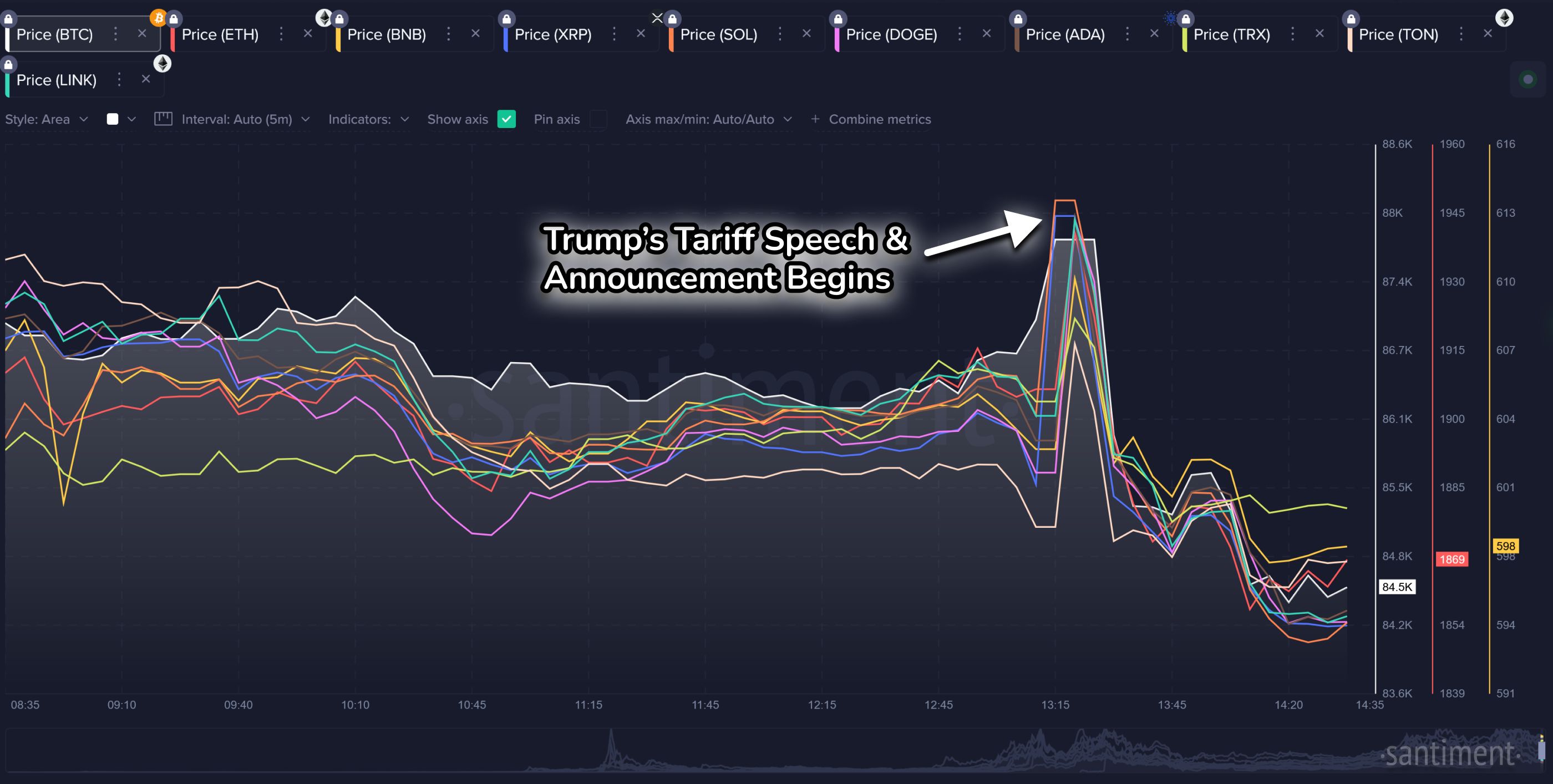 Timing of Trump’s speech, and impact on cryptocurrency prices
Timing of Trump’s speech, and impact on cryptocurrency prices
It was widely speculated that Trump’s announcement was deliberately scheduled for around one hour after US stock markets closed on this day to prevent real-time market volatility and emotional reactions. However, the next morning, Apr 3, 2025, volatility quickly and predictably made up for lost time. The S&P 500 dropped more than 5.1% in trading, and the Nasdaq Composite fell more than 5.6%, reflecting investor concerns about potential economic disruptions and increased inflation. This is officially the fifth-worst performing stock trading day of the 2020s (with the top three all related to Black Thursday in March, 2020).
In contrast, Bitcoin has thus far demonstrated resilience. While traditional markets have reacted negatively to the tariff announcements, Bitcoin's price has dropped relatively little, primarily due to its continued mild correlation with global stock markets. As of Apr 3, 2025, Bitcoin was trading at approximately $81.7K, still 6% above its $77K local bottom from Mar 10, 2025.
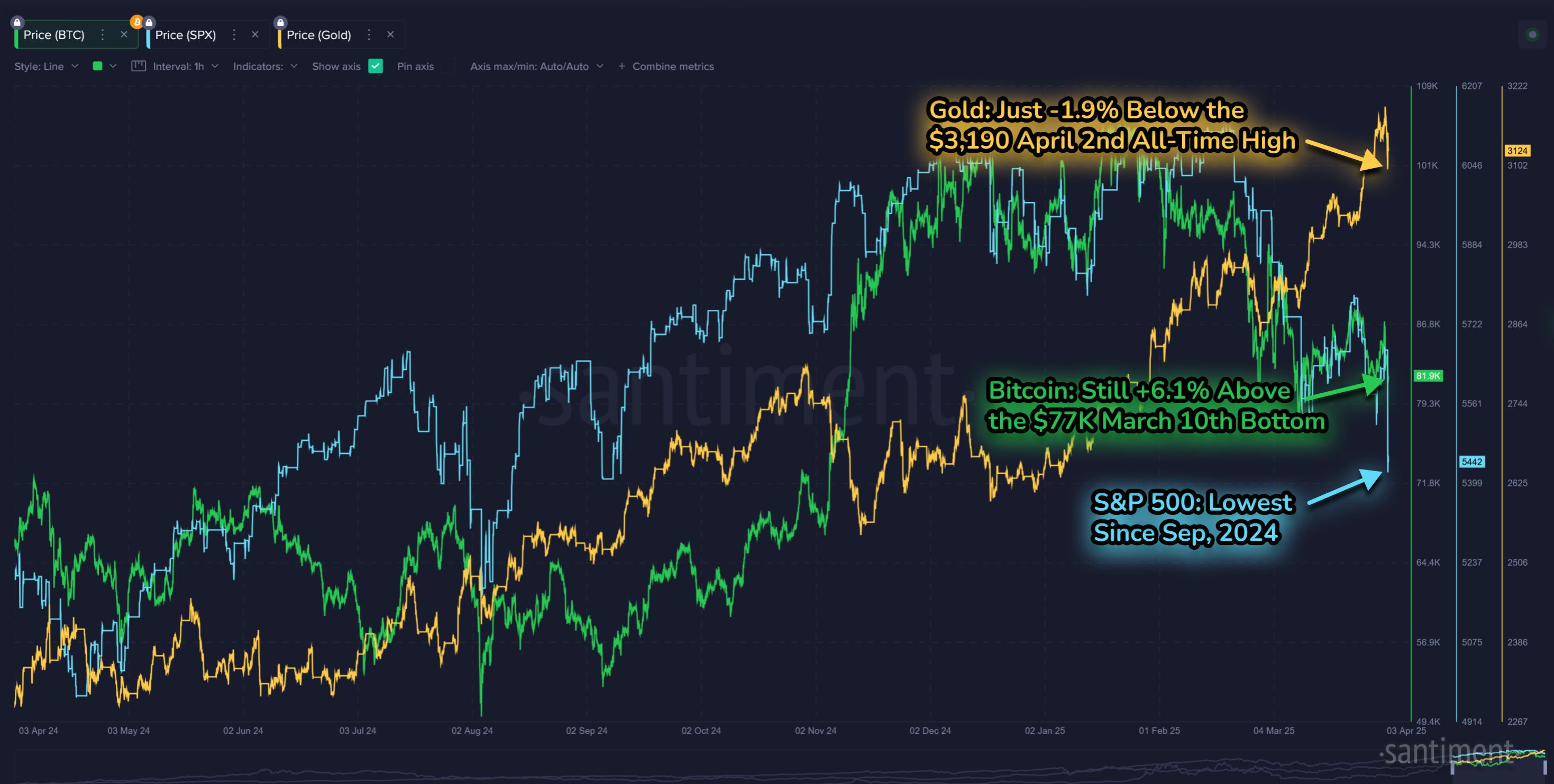 Comparison of gold, Bitcoin and the S&P 500 over the past year
Comparison of gold, Bitcoin and the S&P 500 over the past year
This stability suggests that investors may view cryptocurrencies as a hedge against geopolitical and economic uncertainties. Bitcoin's digital and decentralized nature contributes to its insulation from trade policies that impact physical goods. Unlike traditional assets, Bitcoin is neither subject to import duties nor directly affected by supply chain disruptions.
This allows it and the vast majority of cryptocurrencies to operate independently of policies like tariffs, which can heavily influence markets tied to tangible goods and international trade. Consequently, during events that unsettle traditional financial systems, Bitcoin and similar cryptocurrencies may offer an alternative avenue for investors seeking to diversify their portfolios and mitigate risk.
US Tariff Figures Clarified
The tariffs were expected to be swift and aggressive, and Trump’s revealing of the types of tariffs and associated numbers didn’t disappoint those who were expecting chaos. The US president started off by declaring the event as "Liberation Day,” introducing a two-tier tariff system: there will be a universal 10% tariff on all imports, which goes into effect on Ap 5, 2025, as well as higher, country-specific "reciprocal" tariffs on approximately 60 countries, which go into effect on Apr 9, 2025. The US will be implementing these reciprocal tariffs, meaning they specifically aim to match or counterbalance tariffs already placed by other countries. This contrasts with protective tariffs, which are designed mainly to protect domestic industries from foreign competition, regardless of other nations' tariff policies.
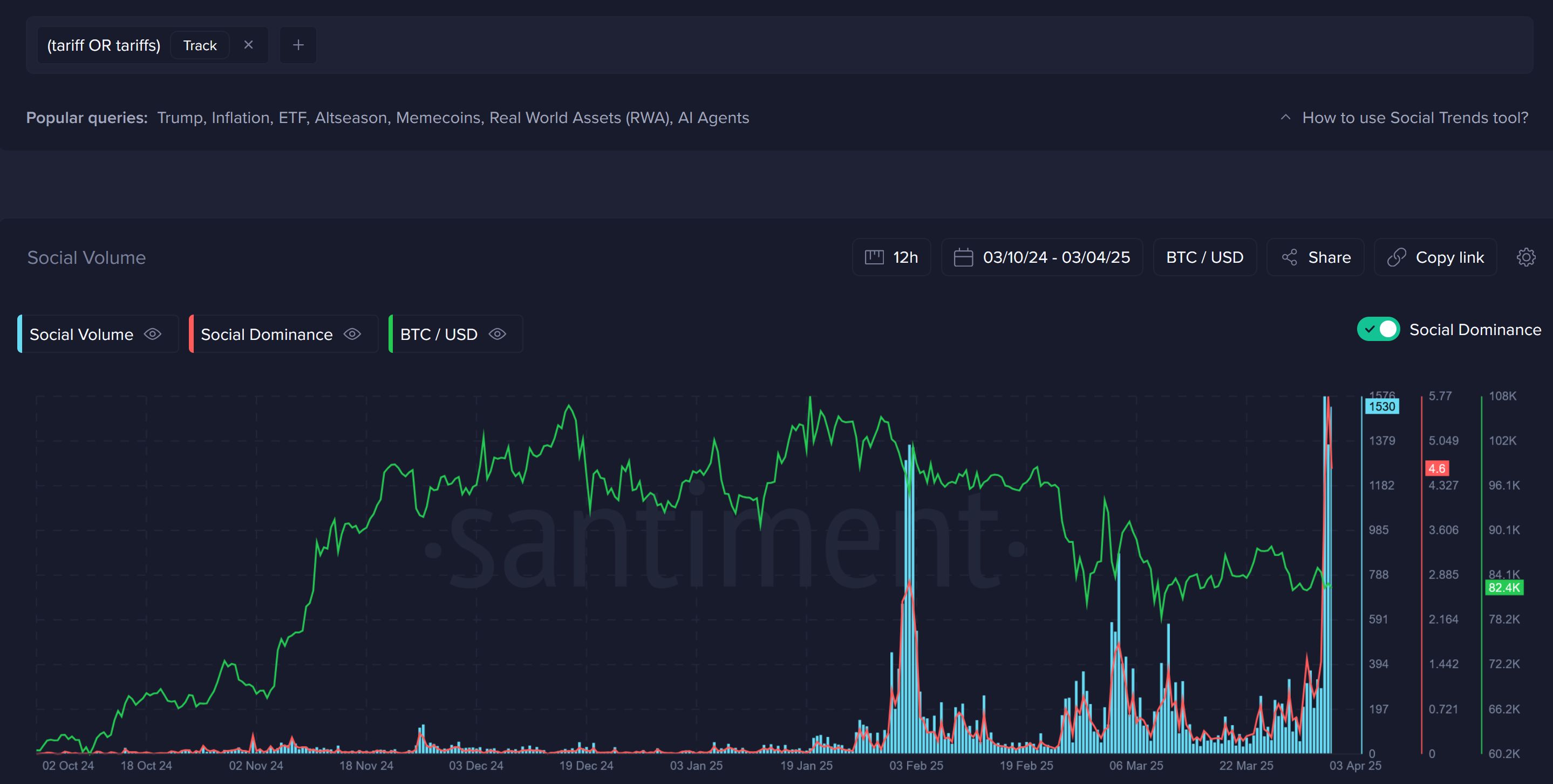 Correlation of Bitcoin’s price with of “tariff” or “tariffs” across social media over the past six months
Correlation of Bitcoin’s price with of “tariff” or “tariffs” across social media over the past six months
The idea behind the “reciprocal” approach is that many countries charge high taxes on American-made products, making them harder to sell abroad. Trump has argued that the current situation is unfair to American businesses and workers. By announcing heavy tariffs on imports from places like China, Japan and the EU, he's pushing these countries and areas to rethink their current policies. If other nations don't make changes, their own goods will become more expensive and less competitive in the US market.
During his speech, President Trump displayed a large chart detailing the tariff rates imposed by various countries on US goods, comparing them to the new tariffs the US would implement in response. This visual aid was used to illustrate perceived disparities in trade policies, and to justify the administration's approach to imposing reciprocal tariffs. The chart aimed to highlight the administration's stance that these measures were necessary to address long-standing trade imbalances, and to encourage other nations to lower their barriers to US exports.
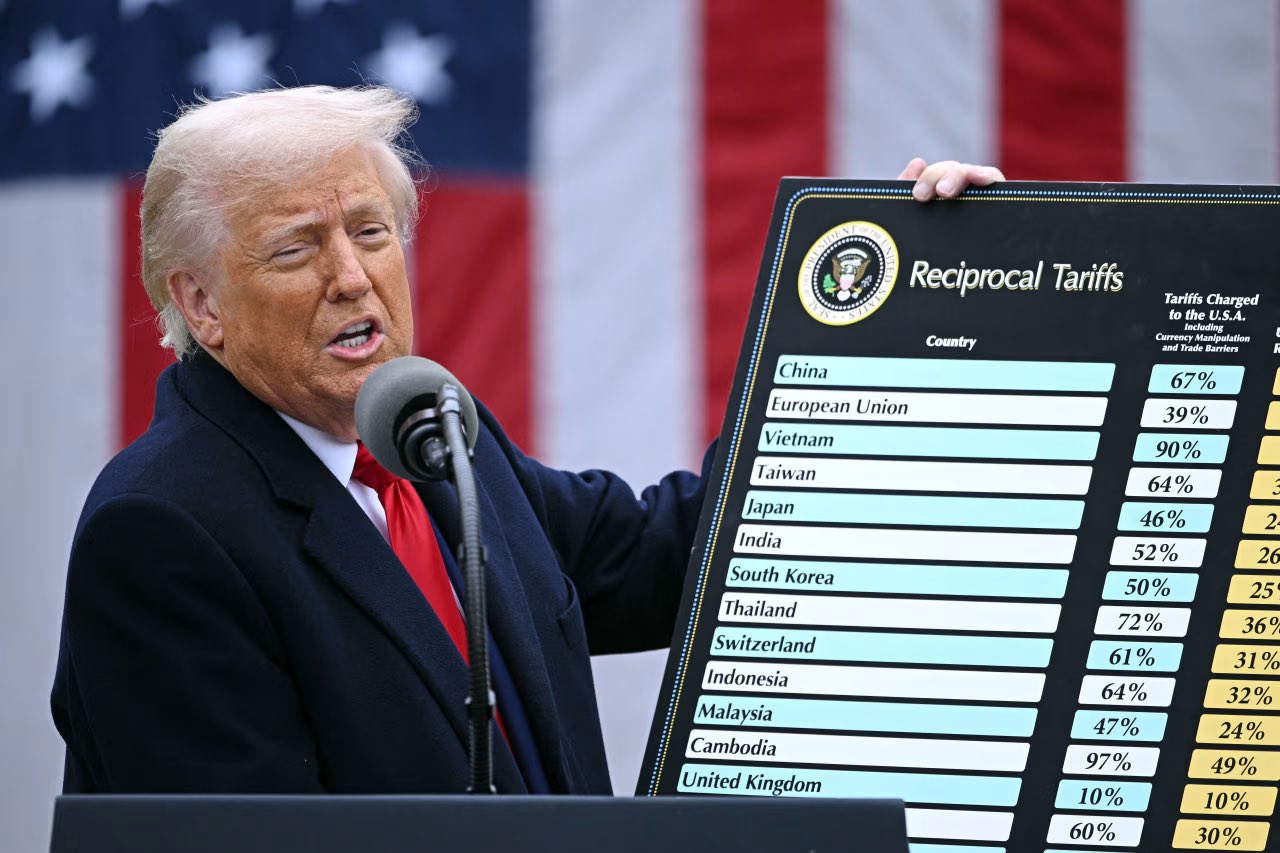 Donald Trump discussing the specifics of his new reciprocal tariffs
Donald Trump discussing the specifics of his new reciprocal tariffs
As for the countries with the highest American tariffs under this plan, Asian countries will feel the greatest impact, with the majority of them receiving a base tariff of 10%:
- Cambodia: 49%
- Laos: 48%
- Madagascar: 47%
- Vietnam: 46%
- Myanmar (Burma): 44%
- Sri Lanka: 44%
- Bangladesh: 37%
- Serbia: 37%
- Botswana: 37%
- Thailand: 36%
Trade war coming, or just a game of chicken?
Economists who prefer proactive trade policy and assertive stances toward unfair trade imbalances often believe that threats of tariffs can force beneficial negotiations. To many in this camp, President Trump's recent tariffs can be seen as a negotiation tactic fondly referred to as a “game of chicken." This means that the US is essentially daring other countries to either accept new trade conditions (which are more beneficial to the US than what are currently in place), or face higher costs when selling goods to the US.
The idea behind this approach is that many countries charge high taxes on products made in America, making them harder to sell as exports. Trump argues that this situation is unfair to American businesses and workers. By announcing heavy tariffs on imports from places like China, Japan and the EU, he's pushing these countries to rethink their current policies. If they don't make changes, their own goods will become more expensive and less competitive in the US market.
Trump hopes that by placing these tariffs, other nations will choose to lower their own taxes on American exports, leading to fairer trade deals. Otherwise, if other countries refuse to cater to these shocking new tariffs, the US claims they are prepared to begin scaling up the infrastructure for more factories and more efficient goods to be built in the US.
Critics argue that playing this tariff "game" could backfire. Instead of lowering their own taxes, some countries might retaliate by placing tariffs on US goods, sparking a trade war that’s harmful to all parties. They worry that businesses, workers and consumers will pay the price through higher costs and economic uncertainty. The effectiveness of Trump's tariffs, therefore, will depend upon whether other nations choose cooperation or confrontation in response.
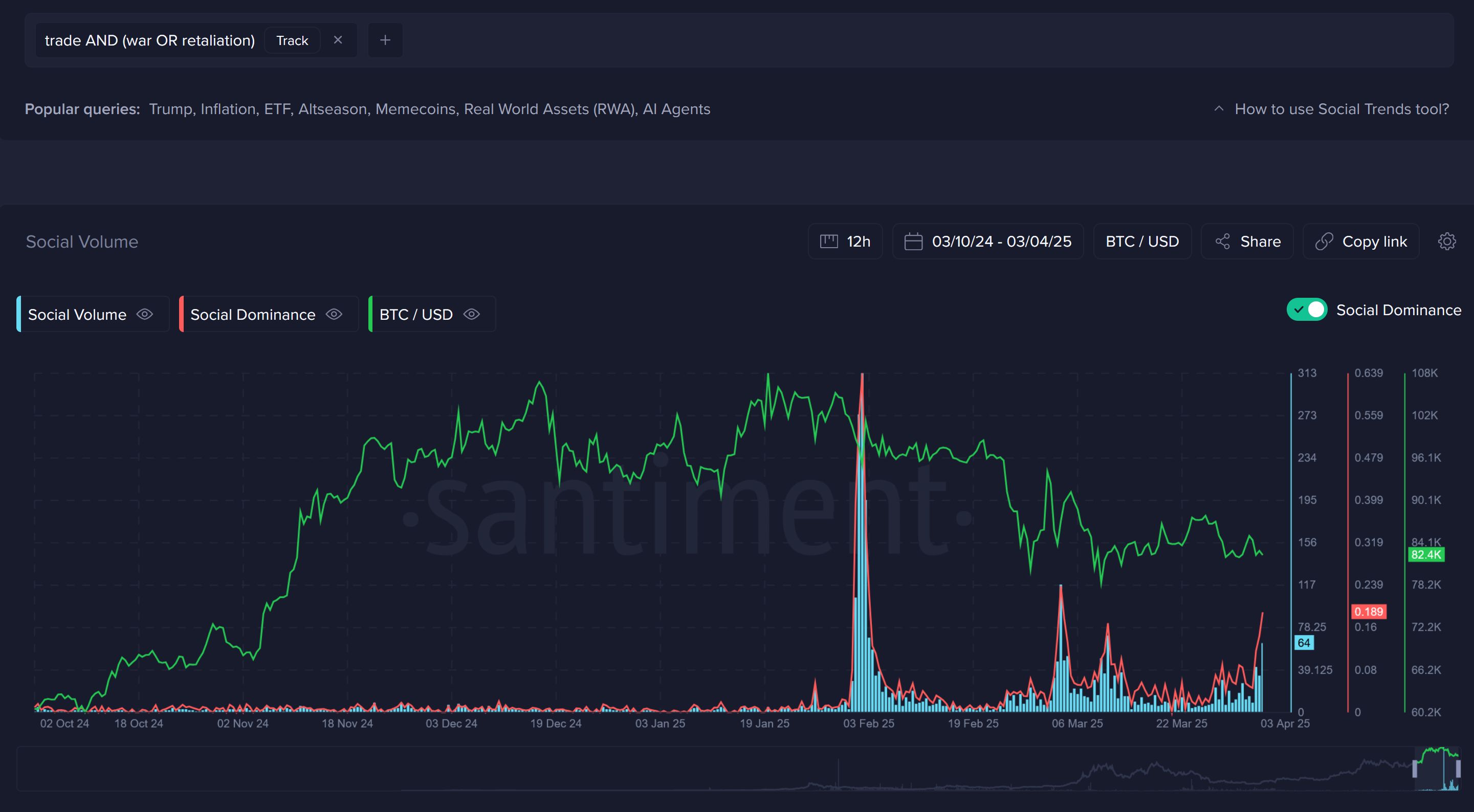 Correlation of Bitcoin’s price with “trade war” or “trade retaliation” across social media over the past year
Correlation of Bitcoin’s price with “trade war” or “trade retaliation” across social media over the past year
On the other hand, supporters of Trump's strategy believe it can work because other countries may worry about losing access to the wealthy American consumer base. The US imports a tremendous number of products, making it an important market for many foreign companies. Countries facing these new tariffs may decide it's better to reduce their export taxes on US goods than risk losing sales. This would theoretically lead to improved conditions for American exports, potentially boosting jobs and profits in the US.
Was AI relied upon?
As reactions to the stunning news came pouring in, many on social media pointed out that the methodology behind the tariff rates was likely concocted at least somewhat with the assistance of artificial intelligence (AI). Analysts observed that the administration's formula closely mirrors calculations generated by AI chatbots (such as ChatGPT) when prompted to devise tariff strategies based on trade deficits. Specifically, the tariffs were determined by dividing the US trade deficit with each country by the total number of imports from that country, and then halving the result.
The context for this scrutiny emerged when users on platforms like X (formerly Twitter) experimented with AI chatbots to propose tariff formulas. They discovered that inputs similar to the administration's approach yielded comparable results from the AI models. For instance, when asked how to calculate tariffs to balance trade deficits with a minimum of 10%, ChatGPT suggested a method akin to the one used by the administration.
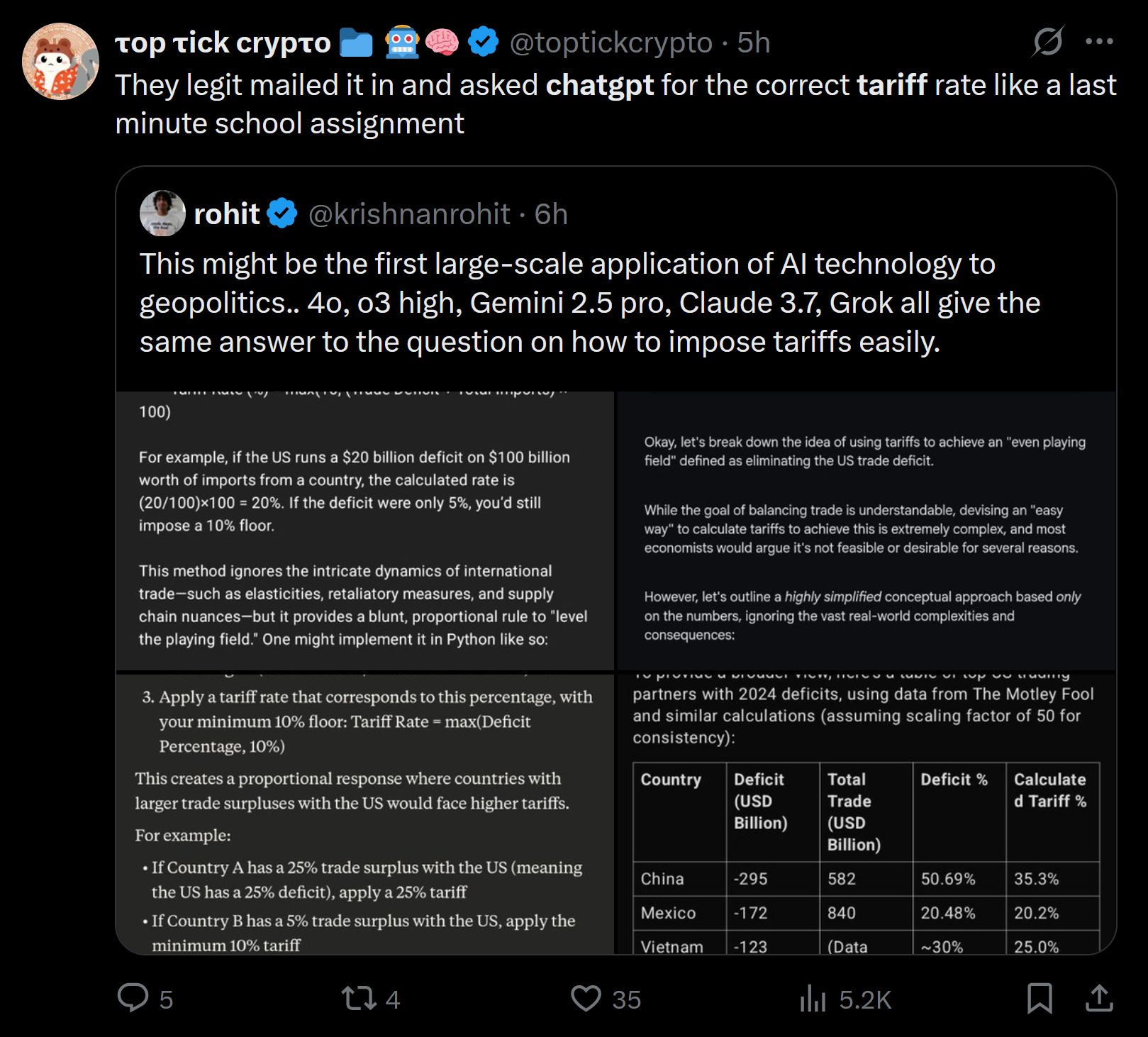 Top Tick Crypto’s repost of Rohit’s summary of AI’s likely role in tariff decisions
Top Tick Crypto’s repost of Rohit’s summary of AI’s likely role in tariff decisions
Many of Trump’s critics (as well as critics of this tariff program) have mocked this reliance on AI-generated formulas for such a significant economic policy. Economists argue that using a simplistic formula overlooks the complexities of international trade, including factors like supply chains, consumer behavior and potential retaliatory measures from trading partners. They contend that formulating tariffs requires nuanced analysis beyond what current AI models can provide, and depending upon such tools may lead to unintended economic consequences.
Michael Saylor and Strategy's Bitcoin accumulation
In other more directly related cryptocurrency news, Michael Saylor's company (formerly MicroStrategy, and just renamed “Strategy”) continued its aggressive acquisition of Bitcoin throughout the past couple of weeks. On Mar 24, 2025, Strategy purchased an additional 6,911 BTC for approximately $584.1M, bringing its total holdings to over 500,000 bitcoins. This purchase was funded through proceeds from common and .
Following this, on Mar 31, 2025, Strategy acquired another 22,048 bitcoins for $1.92 billion, increasing the company’s total holdings to 528,185 bitcoins. The average purchase price for this acquisition was $86,969 per Bitcoin, per Saylor’s official announcement:
 Michael Saylor’s announcement of Strategy’s latest Bitcoin purchase on Mar 31, 2025
Michael Saylor’s announcement of Strategy’s latest Bitcoin purchase on Mar 31, 2025
As prices have dwindled, there’s predictably been a fair amount of backlash to Strategy's continued commitment to Bitcoin as a primary treasury asset. Saylor has faced increasing criticism for continuing to buy large amounts of Bitcoin, especially during periods when prices are falling. Some financial analysts argue that this aggressive strategy exposes the company and its investors to high levels of risk. The concern is that by placing so much of the company’s resources into a single, highly volatile asset like Bitcoin, Strategy could face major losses if the market declines further or fails to recover quickly.
There’s also been growing conversation about what would happen if Strategy were ever forced to liquidate its Bitcoin holdings. Because the company now owns over half a million BTC, any sudden sale could shake investor confidence and cause Bitcoin’s price to fall even more rapidly. Some experts warn that such a scenario could trigger a cascading effect in the broader crypto market, as traders rush to sell and avoid further losses. This fear has led to speculation that Strategy has become a "systemic risk" in the crypto space, similar to the way that large financial institutions can create shockwaves if they fail.
BlackRock's Bitcoin ETP in Europe
BlackRock, the world's largest asset manager, expanded its cryptocurrency offerings by launching its first Bitcoin exchange-traded product (ETP) in Europe. The iShares Bitcoin ETP began trading on Mar 25, 2025, on major European exchanges, including Xetra, Euronext Paris and Euronext Amsterdam. In addition, the product debuted with a temporary fee waiver of 10 basis points (bps), reducing its expense ratio to 0.15% until the end of the year.
This move is seen as a significant step toward mainstream adoption of cryptocurrencies in Europe. Analysts suggest that BlackRock's global reputation and expertise may gradually build momentum for European Bitcoin ETPs, encouraging broader adoption and opening new pathways for institutional capital to enter the crypto market.
Crypto sentiment polarizing, but not bearish (yet)
With the entire cryptocurrency market retracing in early April, it was expected that there would be some severe bearish narratives forming as portfolios shrunk. But more than 24 hours after Trump’s massive tariff moves, the cryptocurrency community remains mixed. This could be due to the fact that Bitcoin, in particular, has held up quite well relative to the stock market bloodbath.
Compared to previous dips throughout 2025, this latest retrace hasn’t quite been perceived as such. The biggest push from the crypto community this year occurred in late February, and mentions related to this topic have been surprisingly dormant.
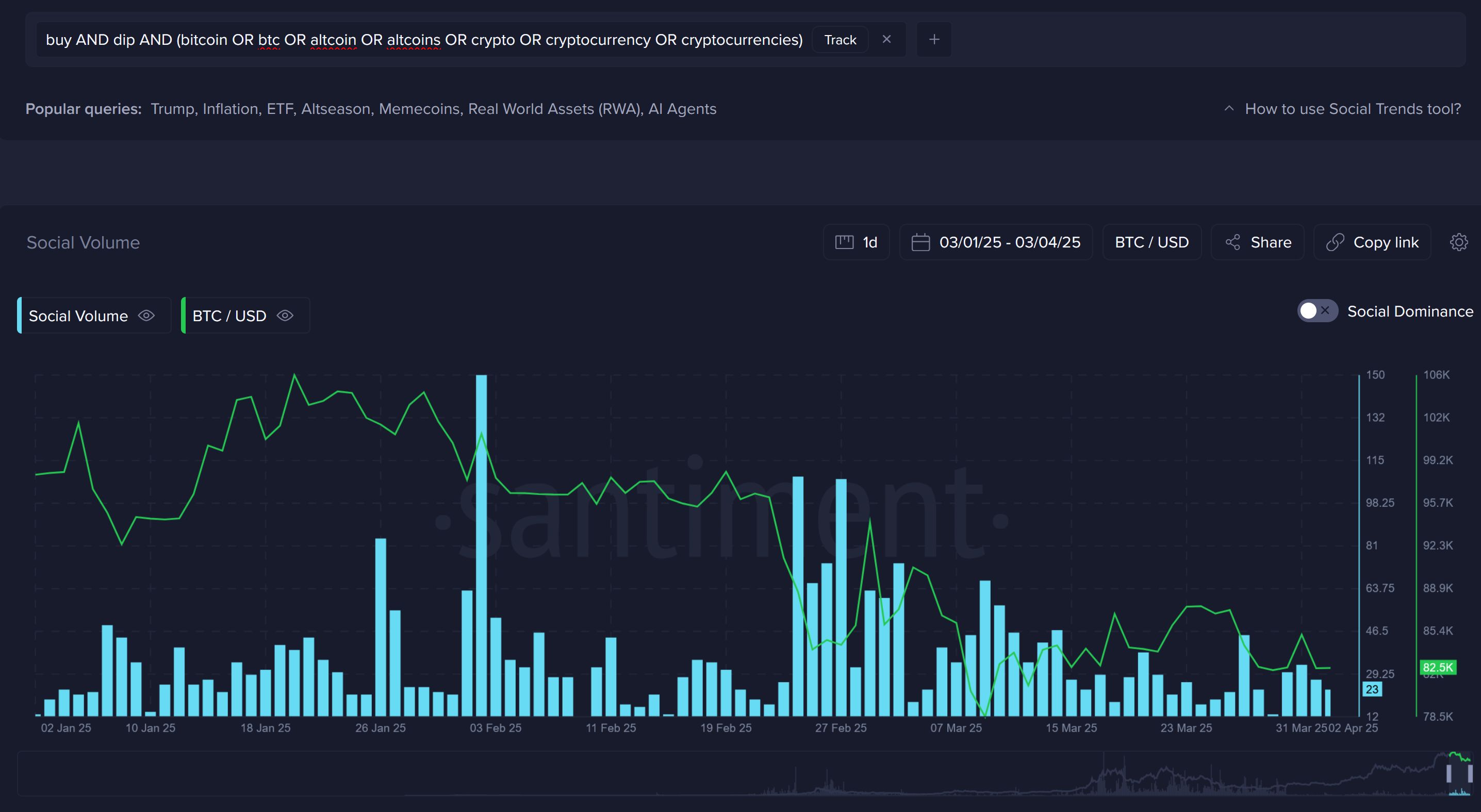 Correlation of Bitcoin’s price with “buy the dip” in crypto across social media over the past three months
Correlation of Bitcoin’s price with “buy the dip” in crypto across social media over the past three months
We also see that overall levels of bullish-vs.-bearish commentary across social media for Bitcoin, Ethereum and XRP are mostly fluctuating in a neutral pattern for the time being. This indicates a lack of panic across social media, with most traders still recognizing that top-cap assets are still trading at market values above the local bottoms from just three weeks ago.
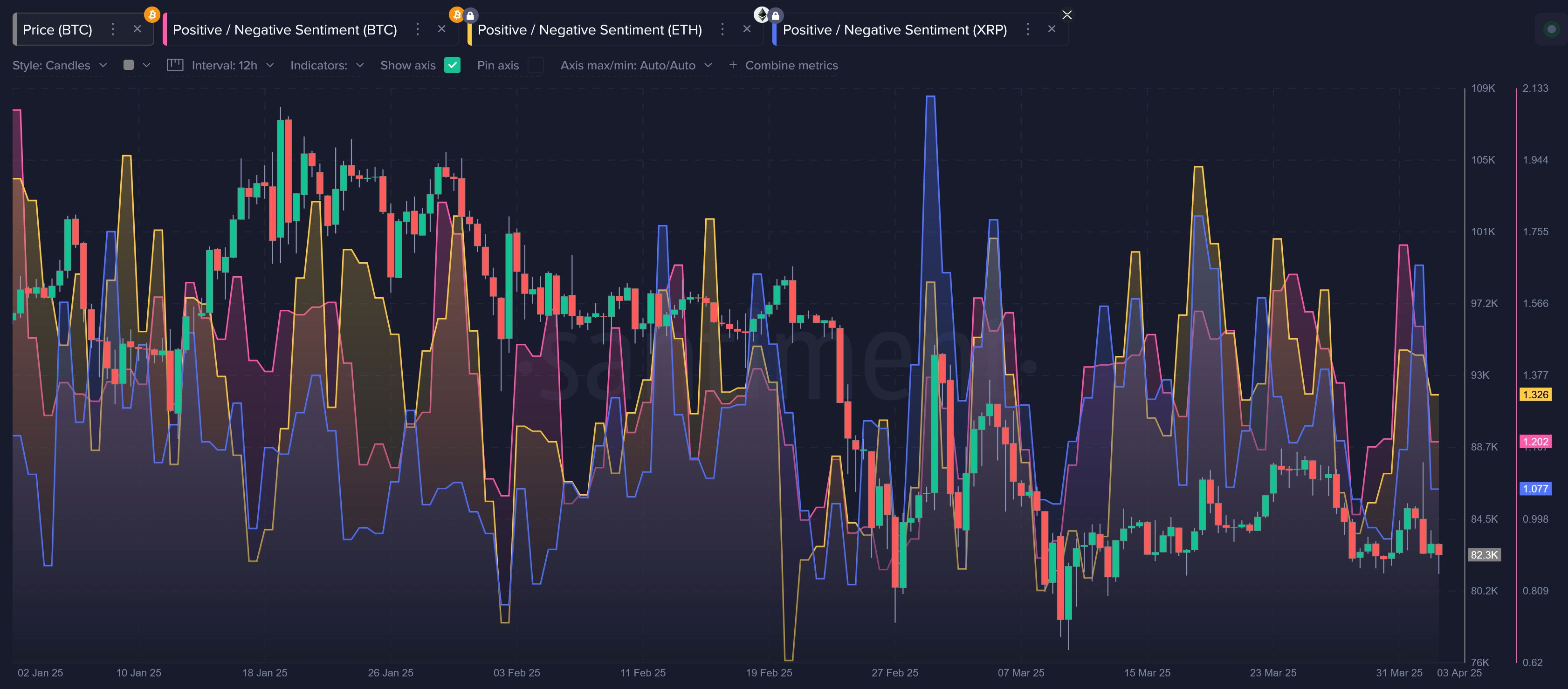 Ratio of positive vs. negative commentary related to BTC, ETH and XRP over the past three months
Ratio of positive vs. negative commentary related to BTC, ETH and XRP over the past three months
Ideally, bullish traders would want to see that their bearish counterparts are both vocal and concerned at the moment. Historically, Santiment data has consistently shown that the biggest crypto rebounds occur when the crowd believes market values will continue to plummet. Typically, this is a reflection of retail sell-offs, while and other key stakeholders accumulate the loose coins being dropped. But for now, there’s an almost eerie feeling of contentment from retailers. This may indicate that markets need to get a bit “worse” before leading to a serious bull cycle, like the one we saw in late 2024.
Stablecoin Backed By US Treasuries
During these past two weeks, World Liberty Financial, a cryptocurrency venture associated with Donald Trump, announced plans to launch a stablecoin called USD1. This digital currency is intended to be backed entirely by US dollars, Treasuries and cash equivalents, aiming to provide a stable and secure medium for cross-border transactions among sovereign investors and major institutions.
The launch of USD1 has sparked mixed reactions. Supporters believe it could bring more trust and stability to digital money, especially for large investors and international transactions. But critics, including Massachusetts Senator Elizabeth Warren, worry about the Trump family's strong political and financial ties, raising concerns about conflicts of interest. Lawmakers are asking how regulators plan to oversee this new stablecoin to make sure it follows the rules.
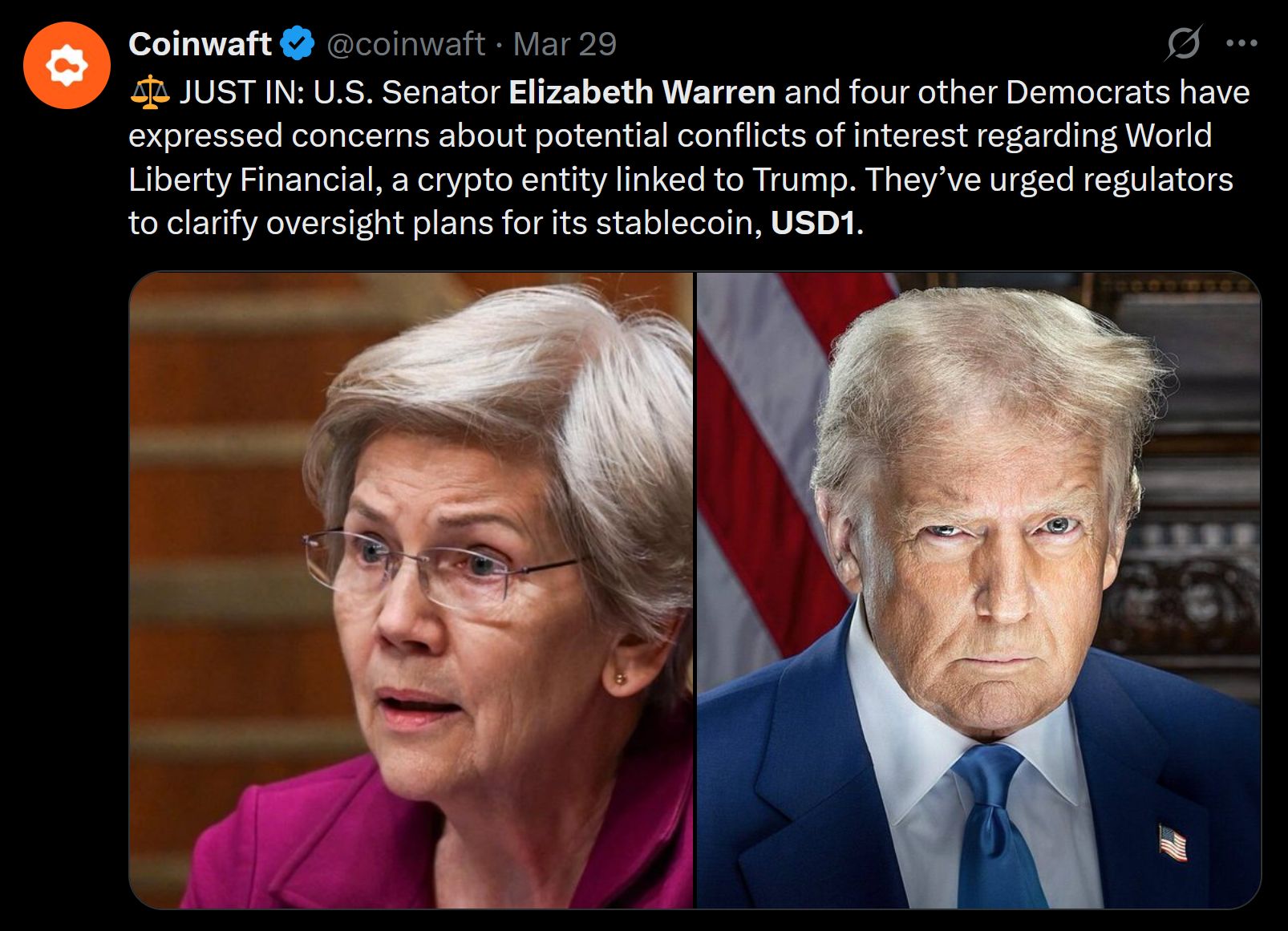 Coinwaft’s announcement of Elizabeth Warren’s concerns related to new USD1 stablecoin
Coinwaft’s announcement of Elizabeth Warren’s concerns related to new USD1 stablecoin
At the same time, Congress is working on new laws to regulate stablecoins such as USD1. The STABLE Act would require strict rules, similar to those for banks, to make sure stablecoin issuers operate safely. USD1 enters a competitive space already dominated by major stablecoins like ), and its success will depend upon building public trust and following regulations. As crypto continues to grow, USD1 shows how digital money, politics and traditional finance are becoming more connected.
Gold's Continued Price Climb
Gold, a traditional safe-haven asset, continues to trade near its all-time high at $3,138. In times of uncertainty — especially involving geopolitical risk, inflation fears or major shifts in global trade — investors often turn to gold as a store of value. With Trump’s sweeping tariffs rattling global markets and raising the specter of a prolonged trade war, demand for gold has increased as a hedge against economic instability. The bullish case is straightforward: if other nations retaliate, or if the global economy enters a downturn due to disrupted supply chains and increased costs, gold could see renewed inflows as investors seek security in tangible, time-tested assets.
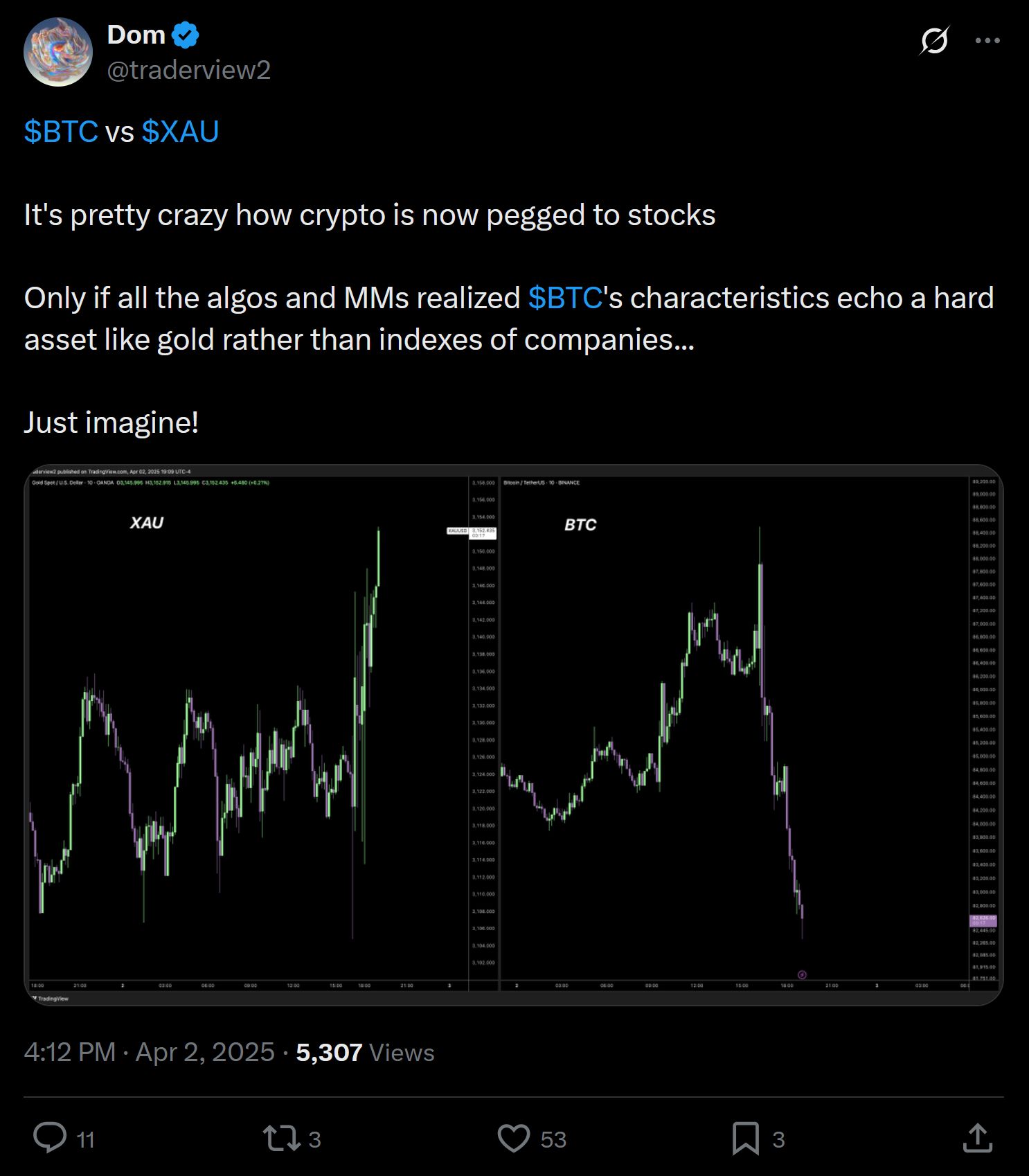 Dom’s comparison of XAU and BTC, stating his position on market makers
Dom’s comparison of XAU and BTC, stating his position on market makers
However, there’s also a compelling bearish perspective, particularly if Trump’s tariff strategy achieves its intended outcome. Should major trade partners decide to negotiate, and reduce their own export taxes on US goods, global tensions may ease sooner than expected. A de-escalation would restore confidence in traditional equity markets and reduce the perceived need for defensive assets, such as gold. Additionally, if the Federal Reserve maintains a stable interest rate environment, and inflation stays in check, gold's appeal could fade in favor of income-generating investments, such as bonds or dividend-paying stocks. In that scenario, gold’s current lofty valuation might struggle to hold, and we could see a gradual price correction.
Ultimately, the direction gold takes in April and beyond will be tightly linked to the global reaction to Trump’s aggressive tariff policies. A fractured world economy with rising political tensions would likely send gold soaring past its current highs. However, if countries show signs of cooperation and a renewed push toward trade realignment, investor focus may shift away from crisis hedges and toward growth opportunities — leaving gold vulnerable to a cooling-off period. As always, gold thrives on fear, and its fate now hinges on whether global markets lean further into chaos or choose a path of de-escalation and compromise.
Crypto Retirement Bill Becoming a Reality?
On Mar 31, 2025, Alabama Senator Tommy Tuberville announced plans to reintroduce the “Financial Freedoms Act” legislation aimed at allowing Americans to include cryptocurrencies in their retirement savings plans. This initiative seeks to scale back regulations imposed by the US Department of Labor over the types of investments permitted in 401(k) retirement plans. The proposed bill reflects a broader effort to integrate digital assets into mainstream financial planning and retirement strategies.
Supporters of Senator Tuberville’s Financial Freedoms Act argue that the bill empowers individuals by giving them more control over their financial futures. By allowing cryptocurrencies in retirement accounts, investors can diversify their portfolios beyond traditional assets like stocks and bonds. Proponents believe this move reflects the growing legitimacy of digital assets and aligns with the modern financial habits of younger generations, who are already familiar with crypto. They also argue that excluding crypto from 401(k) options unfairly limits potential growth opportunities in what has become a multitrillion-dollar global asset class.
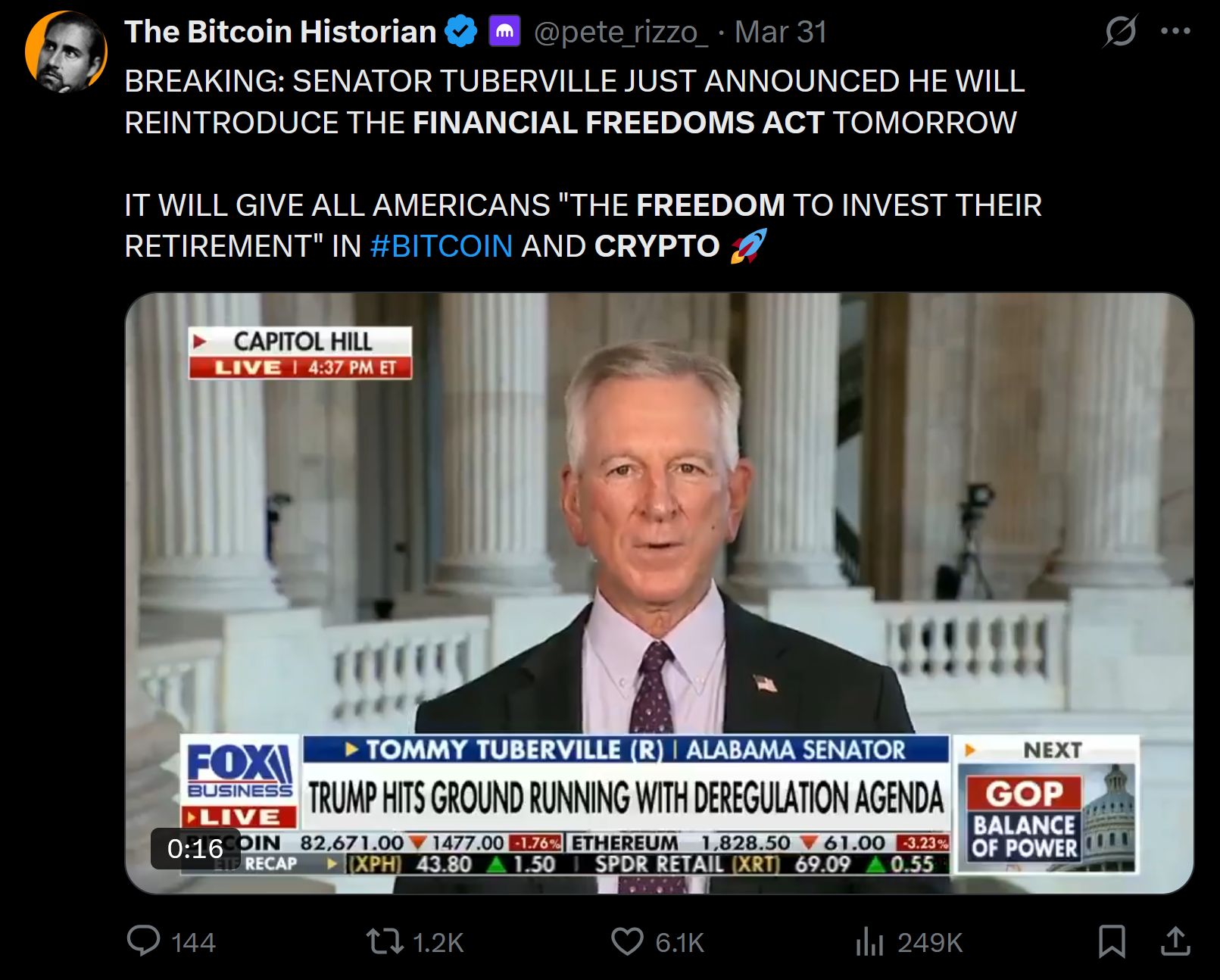 The Bitcoin Historian’s summary of Tommy Tuberville’s Financial Freedoms Act announcement
The Bitcoin Historian’s summary of Tommy Tuberville’s Financial Freedoms Act announcement
Critics, however, warn that the bill exposes retirement savers to unnecessary risk. Cryptocurrencies are known for their extreme volatility, and including them in long-term retirement plans could lead to significant losses — especially for individuals without the expertise to manage such assets wisely. Financial regulators have raised concerns that allowing crypto in 401(k)s may increase the chances of fraud, mismanagement or poor decision-making among unsophisticated investors. Some also argue that easing oversight by the Department of Labor could weaken the consumer protections that retirement plans are supposed to provide.
A Rocky April Ahead?
As we move deeper into April 2025, all eyes will remain on the way international leaders respond to the US's newly implemented tariffs. The next few weeks will reveal whether Trump’s“game of chicken” approach prompts other nations to lower their own export taxes, or triggers retaliatory tariffs that escalate into a full-blown trade war. Markets — both traditional and crypto — are in a wait-and-see mode. Bitcoin’s ability to hold relatively steady amidst the stock market’s steep drop signals growing investor trust, but this could quickly shift if broader economic conditions worsen or if diplomatic tensions rise. Watch closely for signs of trade negotiations or retaliatory responses, especially from China, Japan and the EU, as they face the highest tariff burdens under the new plan.
The cryptocurrency market’s future performance will also heavily depend upon whether key institutional players continue their buying streaks, or take a more cautious approach. Strategy’s massive Bitcoin acquisitions, while bold, have drawn growing scrutiny — and any liquidity crisis involving such a major holder could rattle crypto markets. At the same time, new developments like BlackRock's Bitcoin ETP in Europe and the planned launch of USD1 are setting the stage for an increasingly competitive and politically entangled digital finance ecosystem. Regulatory action around stablecoins and retirement crypto investment bills may also influence sentiment in the weeks ahead, as the US government’s stance on crypto continues to evolve.
Looking ahead, bullish momentum in crypto markets will likely hinge on how much the rest of the world is willing to cooperate with the US in redefining global trade terms. If countries begin to renegotiate trade barriers, and develop mutually beneficial import/export systems, investors may grow more confident in both traditional and digital assets. But if trade tensions escalate, crypto could face spillover effects — especially if capital flight from riskier assets becomes the norm.
For now, the crypto sector sits at a crossroads. Its resilience is notable, but its direction will be shaped not just by technology and adoption, but by geopolitics, regulation and global cooperation.
-----
Free two-week trials to Sanbase PRO (to access all mentioned Santiment data in this article, and plenty more) are
-----
Disclaimer: The opinions expressed in the post are for general informational purposes only and are not intended to provide specific advice or recommendations for any individual or on any specific security or investment product.
Disclaimer: The content of this article solely reflects the author's opinion and does not represent the platform in any capacity. This article is not intended to serve as a reference for making investment decisions.
You may also like
Bitcoin Mining Difficulty Hits New All-Time High
Bitcoin mining difficulty reaches a record high, signaling stronger network security and rising confidence.Stronger Than Ever: What This Milestone MeansWhy It’s Bullish for BitcoinThe Bigger Picture

GMGN Earns $60M in SOL, Powers Solana Growth
GMGN earns $60M in SOL fees, stakes all to support Solana. Transaction speed hits 0.58 seconds.GMGN Stakes $60M to Boost SolanaSolana’s Speed Keeps ClimbingConfidence in the Ecosystem

Phaver Shuts Down as Token Crashes 99% Since TGE
Phaver shuts down after a 99% token crash. Costly listings and no token sales left the team without enough funds to continue.The Fall of Phaver: What Went Wrong?Massive Costs, No RevenueLessons for Web3 Startups

Why the Bitcoin Halving Cycle Is Far From Over
Bitcoin bull markets usually peak 500 days after halving. Here's why there's still time to capitalize.The Cycle Isn’t Over YetUnderstanding the 500-Day PatternHold Steady, Don’t Panic

